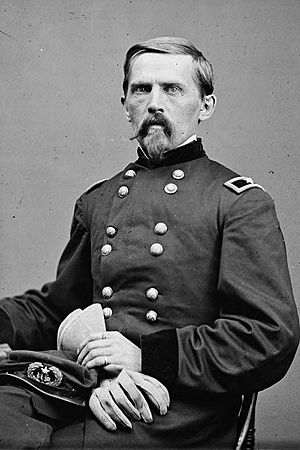William Carlin facts for kids
Quick facts for kids
William Passmore Carlin
|
|
|---|---|

William P. Carlin
|
|
| Born | November 23, 1829 Rich Woods, Greene County, Illinois |
| Died | October 4, 1903 (aged 73) Whitehall, Montana |
| Place of burial |
Carrollton City Cemetery, Carrollton, Illinois
|
| Allegiance | United States of America Union |
| Service/ |
United States Army Union Army |
| Years of service | 1850–1893 |
| Rank | |
| Commands held | 38th Illinois Volunteer Infantry 4th Infantry Regiment Department of the Columbia |
| Battles/wars | Plains Indian Wars Utah War American Civil War |
William Passmore Carlin (born November 23, 1829, died October 4, 1903) was an important soldier from Illinois. He became a general in the Union Army during the American Civil War. After the war, he continued to serve in the United States Army. Carlin led groups of soldiers called brigades and divisions. He fought in many major battles in the western part of the Civil War.
Contents
William P. Carlin: A Life of Service
Early Years and Education
William P. Carlin was born in Rich Woods, Greene County, Illinois. He went to local schools there. His parents were William B. Carlin and Mary Carlin. His uncle, Thomas Carlin, was a veteran of the War of 1812. He also served as the governor of Illinois when William was a boy.
William was accepted into the United States Military Academy at West Point, New York. He graduated in 1850, ranking 20th in his class of 44 students. Six of his classmates later became generals in the Civil War. These included Gouverneur K. Warren and William L. Cabell.
Frontier Adventures
After graduating, Carlin became a second lieutenant. He was assigned to the 6th U.S. Infantry. He spent almost ten years serving on the Western frontier. He was stationed at places like Fort Snelling.
During this time, he took part in several small military actions. These were aimed at stopping conflicts with Plains Indians. In 1855, he joined William S. Harney's campaign against the Sioux tribe. For his service, he was promoted to first lieutenant. In 1857, he was part of Edwin V. Sumner's expedition against the Cheyenne tribe.
Carlin also participated in the Utah War in 1858. He was part of a U.S. Army force led by Albert Sidney Johnston. Johnston later became a general for the Confederate side. Carlin rose to the rank of captain in the Regular Army. From September 1859 to May 1860, he was in charge of Fort Bragg in California.
A Leader in the Civil War
When the Civil War began in 1861, Carlin was quickly called to action. On August 5, he became a colonel. He was the first commander of the new 38th Illinois Infantry regiment. His regiment was sent to Missouri. Their job was to help keep the area under Federal control.
Carlin and his men fought in the Battle of Fredericktown on October 21. They helped defeat part of the Missouri State Guard. Because of his good performance, Carlin was given command of the Southeastern Missouri District in November. He held this position until early 1862.
Leading a Brigade
In the spring of 1862, Carlin was assigned to lead a brigade of infantry. He first led his brigade in battle during the Siege of Corinth in Mississippi. In the autumn, he fought against Confederate General Braxton Bragg in the Kentucky Campaign. Carlin was praised for his bravery at the Battle of Perryville. His charge almost cut off the Confederate escape route.
Carlin was promoted to brigadier general in the Union Army on November 29, 1862. A month later, his brigade suffered many losses at the Battle of Stones River in Tennessee.
For the next year and a half, Carlin commanded the 2nd Brigade. This brigade was part of the 1st Division of the XX Corps. He took part in the Tullahoma Campaign. He also fought in the Battle of Chickamauga. In the fall of 1863, he fought at Lookout Mountain and Missionary Ridge. These were part of the Battles for Chattanooga.
Atlanta and March to the Sea
In the summer of 1864, Carlin led his brigade in the Atlanta Campaign. He took a short break during the campaign to get married in Illinois. He was promoted to lead a division before the Battle of Jonesboro in September. After that, he joined Sherman's March to the Sea. This march ended with the capture of Savannah, Georgia.
In early 1865, Carlin's division was part of the Carolinas Campaign. At the Battle of Bentonville on March 19, his troops made an attack. A large Confederate counterattack pushed them back. General Carlin himself barely escaped being captured. At the end of the war, he was given honorary promotions. He became a major general in both the volunteer Union Army and the Regular Army.
Life After the War
In the summer of 1865, Carlin left the volunteer army. He returned to the Regular Army as a major in the 16th U.S. Infantry. From 1867 to 1868, he worked for the Freedmen's Bureau in Tennessee. This organization helped formerly enslaved people.
He was promoted to colonel in April 1882. Later, he became a brigadier general. He held various commands at army posts across the country. He helped stop a miners' strike in the Idaho Territory. He also served in the South during the Reconstruction period.
Carlin retired from the Army in 1893. He had served for 43 years. He wrote a book about his life called Memoirs of Brigadier General William Passmore Carlin, USA.
Legacy and Remembrance
In 1903, Carlin died suddenly while traveling on a train near Whitehall, Montana. His body was sent back to Carrollton, Illinois, where he was buried.
The town of Carlin, Nevada, was named in his honor.

